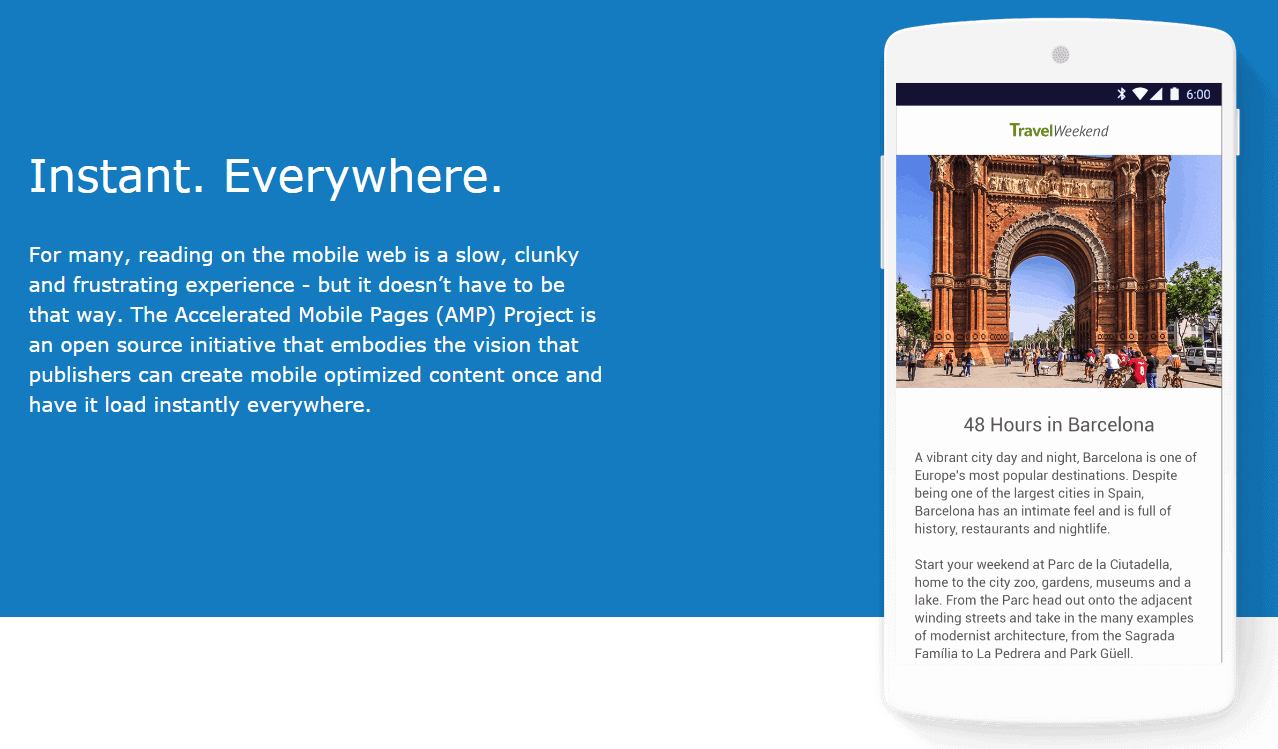What's in this article?
Google has rolled out another new search feature that aids mobile content consumption. The question is whether Accelerated Mobile Pages (AMP) can help your content marketing. As a Michigan web design company, we wanted to take a closer look at what AMP is and whether our web design and SEO clients targeting mobile internet users can benefit. Here’s what we discovered.
What Are Accelerated Mobile Pages?
The Accelerated Mobile Pages Project promises a mobile web that’s “Instant. Everywhere.” Notes Google:
For many, reading on the mobile web is a slow, clunky and frustrating experience — but it doesn’t have to be that way. The Accelerated Mobile Pages (AMP) Project is an open source initiative that embodies the vision that publishers can create mobile optimized content once and have it load instantly everywhere.
The feature now displays a series of visually appealing AMP articles for Google search users at the top of the search engine results page (SERP), when that content is relevant to the user’s search query. AMP content is above top-ranking SERP entries and sponsored search results.
Google digs further into the details of how this new website framework will work on its blog:
We want webpages with rich content like video, animations and graphics to work alongside smart ads, and to load instantaneously. We also want the same code to work across multiple platforms and devices so that content can appear everywhere in an instant—no matter what type of phone, tablet or mobile device you’re using. The project relies on AMP HTML, a new open framework built entirely out of existing web technologies, which allows websites to build light-weight webpages.
Should Your Website Implement AMP?
So knowing more about what AMP is, should your website jump on board this new web technology? The answer depends on a number of factors: your business model, business goals, human and budgetary resources, and how content factors into your business.
Here are a few points to aid your decision-making:
Is it an easy fix to make a site AMP-compatible?
Developers will definitely need to spend some time implementing the AMP framework. This is a significant website update, so the usual cost/benefit analysis should be an early discussion. AMP uses its own stripped-down HTML as well as its own JavaScript (JS) framework and an optional content delivery network (CDN). The project also requires your site to maintain two versions of each article — your regular article which will be viewed by regular visitors and an AMP version.
What are the drawbacks?
As Search Engine Land notes, the limitations that come with streamlining for AMP mean some existing website features don’t work in AMP versions. Namely, third-party JavaScript and form elements, meaning on-page comment sections, lead forms, and such aren’t compatible. However, there is reportedly a workaround hack for this. There’s also a number of extended components that must be used for a laundry list of typical website features, including images, GIFs, custom fonts, video content, slideshows, image galleries, and social media.
What about ads, analytics, subscriptions, and paywalls?
There are also extended components for these page elements, too. It’s clearly in Google’s interest that AdWords and Google Analytics integrate easily with the AMP framework, so these Google add-ons are compatible, along with comparable third-party offerings. Google also created a system for letting publishers control public and behind-the-wall content.
Who stands to gain the most from AMP?
Businesses that embrace the value shared by Google and its partners that “the mobile web [should] work better for everyone” stand to profit the most — provided they put in the time and code to make their content AMP-compliant. Sites that do implement could see increased mobile traffic — which could lead to increased ad revenue, increased conversions, and increased sales — but that’s just speculation at this point. So far, the biggest adopters appear to be major journalistic outlets, such as the Guardian and the Washington Post.
Why is Google pursuing this project?
Google has a clear interest in being out in front on mobile web. Despite the exponential growth of mobile internet use, recent data indicates only 5% of mobile users’ time is spent on the mobile web. Most time is spent on apps. The tech giant has its work cut out for it. Facebook’s Instant Articles and Apple News are pursuing the same user audience.
Wondering whether AMP could help you reach your content marketing, web design and SEO goals? Call 313-338-9515 or email hello@kaleidico.com to learn how our Michigan web design company can help your business.

